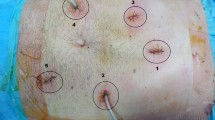Abstract
Background
Currently, minimally invasive approach is preferred for the treatment of ventral hernias. After the introduction of extended view totally extraperitoneal (e-TEP) technique, there has been a constant debate over the choice of better approach. In this study, we compare the short-term outcomes of e-TEP and laparoscopic IPOM Plus repair for ventral hernias.
Methods
This is a comparative, prospective single-center study done at GEM Hospital and research center Coimbatore, India from July 2018 to July 2019. All patients who underwent elective ventral hernia surgery with defect size of 2 to 6 cm were included. Patient demographics, hernia characteristics, operative and perioperative findings, and postoperative complications were systematically recorded and analyzed.
Results
We evaluated 92 cases (n = 92), 46 in each group. Mean age, sex, BMI, location of hernia, primary and incisional hernia, and comorbidity were comparable in both the groups. Mean defect size for IPOM Plus and e-TEP was 4 cm and 3.89 cm, respectively. Operative time was significantly higher for e-TEP, while postoperative pain (VAS), analgesic requirement, and postoperative hospital stay were significantly less as compared to IPOM Plus. However, 2 cases (4.35%) of e-TEP had recurrence but none in IPOM Plus group.
Conclusion
e-TEP is an evolving procedure and comparable to IPOM Plus in terms of postoperative pain, analgesic requirement, cost of mesh, and length of hospital stay. More randomized controlled and multicentric studies are required with longer follow-up to validate our findings.






Similar content being viewed by others
References
Robinson T, Clarke J, Schoen J, Walsh M (2005) Major mesh-related complications following hernia repair events reported to the food and drug administration. Surg Endosc 19:1556–1560
Holihan J, Nguyen D, Nguyen M, Mo J, Kao L, Liang M (2016) Mesh location in open ventral hernia repair: a systematic review and network meta-analysis. World J Surg 40(1):89–99
Daes J (2012) The enhanced view-totally extraperitoneal technique for repair of inguinal hernia. Surg Endosc 26:1187–1189
Belyansky I, Daes J, Radu VG, Balasubramanian R, Reza Zahiri H, Weltz AS et al (2018) Anovel approach using the enhanced-view totally extraperitoneal (eTEP) technique for laparoscopic retromuscular hernia repair. Surg Endosc 32:1525–1532
Prakhar G, Parthasarathi R, Cumar B et al (2020) Extended view: totally extra peritoneal (e-TEP) approach for ventral and incisional hernia—early results from a single center. Surg Endosc. https://doi.org/10.1007/s00464-020-07595-4
Vorst A, Kaoutzanis C, Carbonell A, Franz M (2015) Evolution and advances in laparoscopic ventral and incisional herniarepair. World J Gastrointest Surg 27(7):293–305
Poelman M, Apers J, Brand H, Cense H, Consten E, Deelder J, DwarsB GN, Lange E, Simmermacher R, Simons M, Sonneveld E, Schreurs H, Bonjer J (2013) The INCH-trial: a multicenter randomized controlled trial comparing the efficacy of conventional open surgery and laparoscopic surgery for incisional hernia repair. BMC Surg 13(8):13–18
Schwarz J, Reinpold W, Bittner R (2017) Endoscopic mini/less open sublay technique (EMILOS)-a new technique for ventral hernia repair. Langenbecks Arch Surg 402(1):173–180
Iqbal C, Pham T, Joseph A, Mai J, Thompson G, Sarr M (2007) Long-term outcomes of 254 complex incisional hernia repairs using the modified Rives-Stoppa technique. World J Surg 31(12):2398–2404
Novitsky YW, Elliott HL, Orenstein SB, Rosen MJ (2012) Transversus abdominis muscle release: a novel approach to posterior component separation during complex abdominal wall reconstruction. Am J Surg 204:709–716
Binnebösel M, Klink CD, Otto J, Conze J, Jansen PL, Anurov M et al (2010) Impact of mesh positioning on foreign body reaction and collagenous ingrowth in a rabbit model of open incisional hernia repair. Hernia 14:71–77
Penchev D, Kotashev G, Mutafchiyski V (2019) Endoscopic enhanced-view totally extraperitoneal retromuscular approach for ventral hernia repair. Surg Endosc 33:3749–3756
Baig SJ, Priya P (2019) Extended totally extraperitoneal repair (eTEP) for ventral hernias: Short-term results from a single centre. J Minim Access Surg 15(3):198–203
Brill JB, Turner PL (2011) Long-term outcomes with transfascial sutures versus tacks in laparoscopic ventral hernia repair: a review. Am Surg 77(4):458–465
Nguyen S, Divino C, Buch K, Schnur FNP, Weber J, Katz KMD, Reiner L, Aldoroty M, Herron RD (2008) Postoperative pain after laparoscopic ventral hernia repair: a prospective comparison of sutures versus tacks. JSLS 12(2):113–116
Earle D, Roth J, Saber A, Haggerty S, Bradley J, Fanelli R, PriceR RW, Stefanidis D (2016) SAGES guidelines for laparoscopic ventral hernia repair. Surg Endosc 30(8):3163–3183
Funding
No financial support was taken for this study.
Author information
Authors and Affiliations
Corresponding author
Ethics declarations
Disclosures
Dr. Neeraj Kumar, Dr. V. P. Nalankilli, Dr. R. Parthasarathi, Dr. Sandeep C. Sabnis, Dr. Sunil Kumar Nayak, and Dr. Chinnusamy Palanivelu have no conflicts of interest or financial ties to disclose.
Additional information
Publisher's Note
Springer Nature remains neutral with regard to jurisdictional claims in published maps and institutional affiliations.
Rights and permissions
About this article
Cite this article
Kumar, N., Palanisamy, N.V., Parthasarathi, R. et al. A comparative prospective study of short-term outcomes of extended view totally extraperitoneal (e-TEP) repair versus laparoscopic intraperitoneal on lay mesh (IPOM) plus repair for ventral hernia. Surg Endosc 35, 5072–5077 (2021). https://doi.org/10.1007/s00464-020-07990-x
Received:
Accepted:
Published:
Issue Date:
DOI: https://doi.org/10.1007/s00464-020-07990-x




